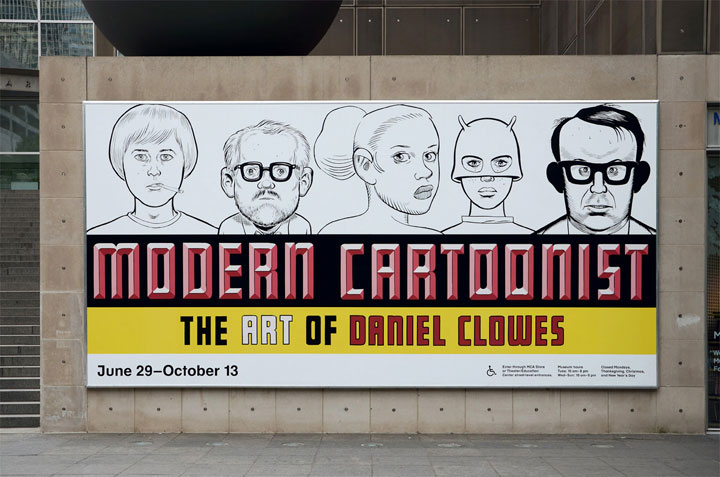
Exterior of The Museum of Contemporary Art, Chicago. Image courtesy of Berny Tan.
Currently on view at the Museum of Contemporary Art Chicago is
Modern Cartoonist: The Art of Daniel Clowes,
the very first museum retrospective to survey the work of the acclaimed
comic book artist and graphic novelist. The Chicago-born, Oakland-based
Clowes is responsible for such cult classics as
Like a Velvet Glove Cast in Iron (1993),
Ghost World (1997, and its 2001 film adaptation of the same name),
David Boring (2000), and
The Death-Ray (2011). An expanded version of a 2012 exhibition at the Oakland Museum of California,
Modern Cartoonist presents more than 125 original illustrations and artifacts within thoughtfully designed exhibition spaces.
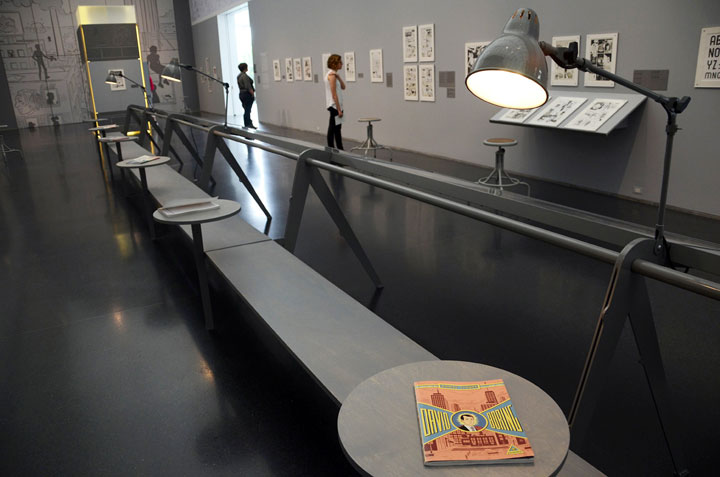
Installation shot of Modern Cartoonist: The Art of Daniel Clowes at The Museum of Contemporary Art, Chicago, August 2013. Image courtesy of Berny Tan.
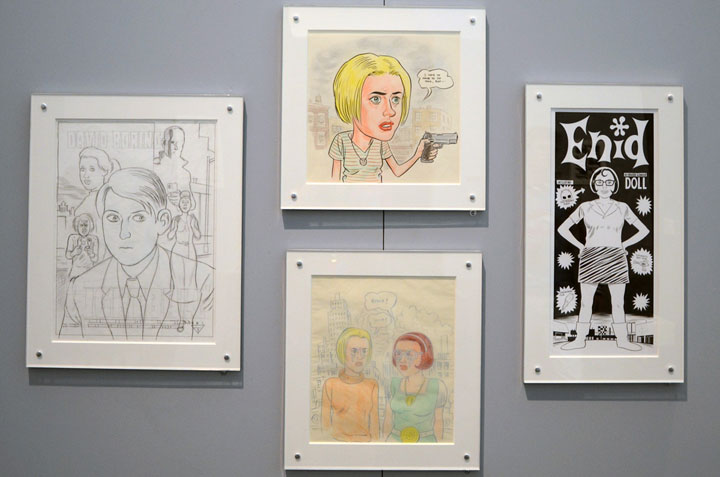
Installation shot of Modern Cartoonist: The Art of Daniel Clowes at The Museum of Contemporary Art, Chicago, August 2013. Image courtesy of Berny Tan.
From deftly executed ink and Zipatone drawings to rich, saturated
gouache paintings and rough graphite sketches, the works on display well
validate Clowes’s abilities as a draftsman. One can imagine an excited
Clowes fan devouring the pages upon pages of his illustrations on view
in their bare, black-and-white form. For the rest of us, there is
something to appreciate in both the meticulous lettering and literary
content of each speech bubble. Single-page excerpts from Clowes’s most
well-known comics are more than enough to bait the uninitiated into
spending time with their bleak and often twisted narratives. In
addition, two 20-foot-high monochromatic murals, featuring silhouettes
of Clowes’s characters situated within urban Chicago, are pleasant,
unexpected bookends to the exhibition’s drawings and publications.
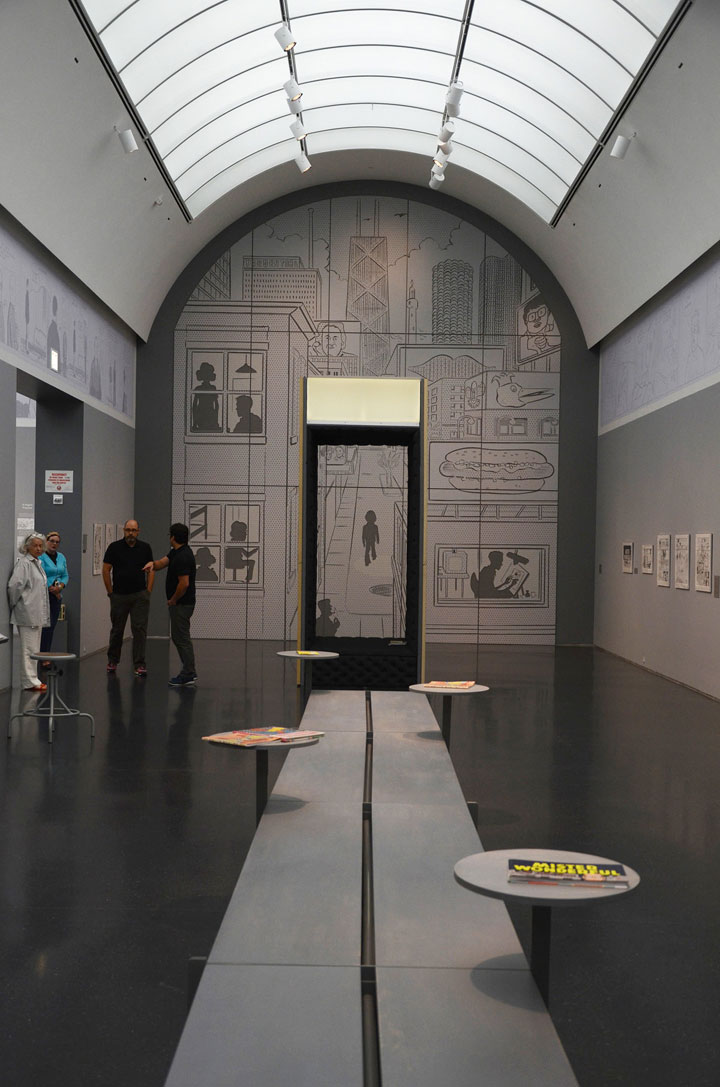
Installation shot of Modern Cartoonist: The Art of Daniel Clowes at The Museum of Contemporary Art, Chicago, August 2013. Image courtesy of Berny Tan.
The exhibition is a joy to experience due not only to the immersive
nature of Clowes’s work, but also to the exhibition design of Nicholas
de Monchaux, who created a comfortable environment within which
illustrations could be appreciated and comics perused. It would have
been easy for de Monchaux to succumb to the seductively bright color
palette of Clowes’s gouache paintings, or the muted yet diverse tones of
his graphic novels. Instead, the designer opts for subtle shades of
calming grays for the walls and fixtures. Ample seating is provided in
the form of benches (lamps and tables included) and intimate spaces with
upholstered seating where one might sit for hours on end reading
Clowes’s graphic novels from cover to cover.

Daniel Clowes, Eightball 18
(cover), 1997. Gouache on white board, 24 3/4 x 22 1/2 x 1/2 inches.
Collection of Daniel Clowes. Image courtesy of the artist and Oakland
Museum of California.
Six decades after the inception of pop art and accompanying
discussions of high-art-versus-low-art, today any debate about whether
Clowes’s work belongs in a fine art museum should be rendered moot.
However, questions regarding if and how we should compare Clowes and his
peers to such artists as Roy Lichtenstein still remain, since we can
expect both to continue inhabiting museums. Curator of the exhibition
Susan Miller has commented on the similarities between Clowes’s style
and the flatness of paintings by Alex Katz, as if to legitimize Clowes
and the exhibition; the framing and display of Clowes’s illustrations
lend a certain fine art regality to his oeuvre.
The issue here goes beyond the tired back-and-forth about whether a
cartoonist should be viewed as a ‘fine artist.’ The museum setting
inevitably transforms the way that someone might otherwise relate to
comics and graphic novels, which require much more time than today’s
average museum-goer would accord to an artwork. How does one relate to
material that is as much literary as it is visual within an art
exhibition? Is the viewer willing to spend hours—in an exhibition space
designed with that in mind—not just admiring Clowes’s inking technique,
but also the dark and dysfunctional narratives that jar with his
deceptively simple aesthetic? How does the art museum do justice to the
works’ literary aspects in addition to their aesthetic ones?
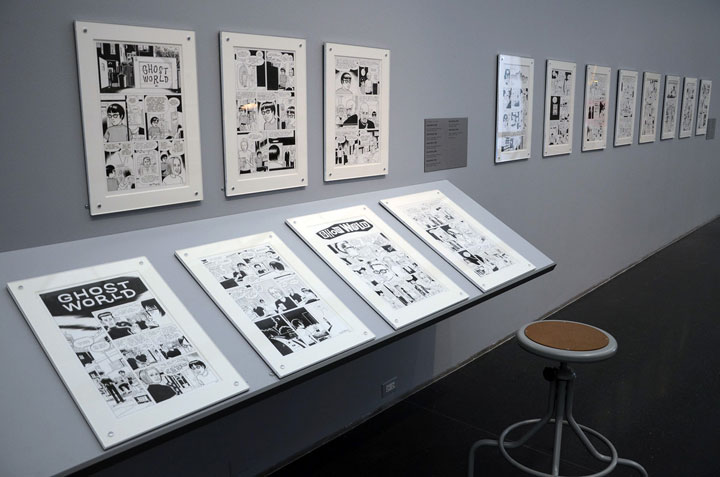
Installation shot of Modern Cartoonist: The Art of Daniel Clowes at The Museum of Contemporary Art, Chicago, August 2013. Image courtesy of Berny Tan.

Installation shot of Modern Cartoonist: The Art of Daniel Clowes at The Museum of Contemporary Art, Chicago, August 2013. Image courtesy of Berny Tan.
An exhibition such as
Modern Cartoonist, intentionally or
not, raises questions about the role of the museum in today’s world and
its responsibilities in terms of education, experimentation, and even
entertainment. It provides a refreshingly accessible and engaging
experience to an audience with a diverse set of approaches, creating
conditions that challenge both museum-goers and comics enthusiasts alike
to consider Clowes’s work in a new context.
–Berny Tan, Communications Intern
Modern Cartoonist: The Art of Daniel Clowes
runs through October 13 at the Museum of Contemporary Art Chicago (220 East Chicago Avenue, Chicago, IL 60611).









